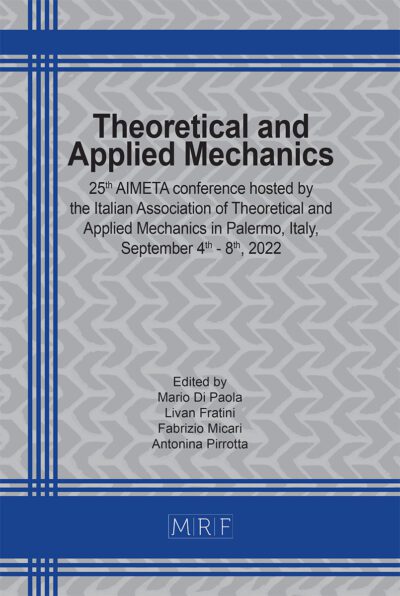Numerical modeling of the process parameters in the pultrusion of preconsolidated polypropylene/glass tapes
Paolo DE SIO, Vitantonio ESPERTO, Fausto TUCCI, Pierpaolo CARLONE
Abstract. The scientific community is devoting consistent efforts to modify the conventional processes used to manufacture pultrusion of thermoset matrix composites and adapt them to thermoplastics. Several promising variants of this process have been developed, such as reaction injection pultrusion, pultrusion of commingled yarns, and pultrusion of pre-consolidated tapes. This study aims to improve the understanding of the pultrusion of pre-consolidated thermoplastic tapes using numerical modeling and simulation of the rheological, chemical, and thermal aspects. The dies of an experimental laboratory-scale pultrusion line used in previous experiments have been reproduced in the numerical environment of a commercial simulation suite. The process is highly sensitive to variations in the process parameters, such as the combination of heating temperature and pulling velocity that defines the heating-cooling cycle. The number of tapes determines the quantity of fibers and matrix included which in turn affects the permeability of the fibrous medium, evaluated using the Gebart permeability model, and influences the thermoplastic flow. The numerical model implemented aims to study heat transfer and thermoplastic flow, considering previous characterizations of polypropylene kinetic and rheological data from scientific literature. The process has been modeled considering three different levels for pulling velocity and heating temperature. A coupled heat-transfer and flow model of the thermoplastic pultrusion has been implemented in the numerical environment of a commercial simulation suite.
Keywords
Tapes Pultrusion, Thermoplastic Composites, Numerical Simulation
Published online 5/7/2025, 8 pages
Copyright © 2025 by the author(s)
Published under license by Materials Research Forum LLC., Millersville PA, USA
Citation: Paolo DE SIO, Vitantonio ESPERTO, Fausto TUCCI, Pierpaolo CARLONE, Numerical modeling of the process parameters in the pultrusion of preconsolidated polypropylene/glass tapes, Materials Research Proceedings, Vol. 54, pp 373-380, 2025
DOI: https://doi.org/10.21741/9781644903599-41
The article was published as article 41 of the book Material Forming
![]() Content from this work may be used under the terms of the Creative Commons Attribution 3.0 license. Any further distribution of this work must maintain attribution to the author(s) and the title of the work, journal citation and DOI.
Content from this work may be used under the terms of the Creative Commons Attribution 3.0 license. Any further distribution of this work must maintain attribution to the author(s) and the title of the work, journal citation and DOI.
References
[1] D. Spasova, Y. Argiro, T. Mechkarova, Comparative Analysis of the Mechanical Properties of Polymer Matrix Composites Reinforced with Fiberglass Fabric, TEM J. 10(4) (2021) 1745–1750. https://doi.org/10.18421/TEM104-35
[2] B. De, M. Bera, D. Bhattacharjee, B. C. Ray, S. Mukherjee, A comprehensive review on fiber-reinforced polymer composites: Raw materials to applications, recycling, and waste management, Prog. Mater. Sci. 146 (2024) 101326. https://doi.org/10.1016/j.pmatsci.2024.101326
[3] B. Parveez, M. I. Kittur, I. A. Badruddin, S. Kamangar, M. Hussien, M. A. Umarfarooq, Scientific Advancements in Composite Materials for Aircraft Applications: A Review, Polymers 14(22) (2022) 5007. https://doi.org/10.3390/polym14225007
[4] M. A. A. El-baky, M. M. A. Allah, M. Kamel, W. Abdel-Aziem, Fabrication of Glass/Jute Hybrid Composite over Wrapped Aluminum Cylinders: An Advanced Material for Automotive Applications, Fibers Polym. 24 (2023) 143–155. https://doi.org/10.1007/s12221-023-00116-9
[5] Y. Sun, C. Hu, C. Li, Y. Qu, M. Ji, M. Chen, Performance and application of pultrusion-processed fibre-reinforced composites in large-scale wind turbine blades, J. Reinf. Plast. Compos. (2024). https://doi.org/10.1177/07316844241256806
[6] F. Rubino, A. Nisticò, F. Tucci, P. Carlone, Marine Application of Fiber Reinforced Composites: A Review, J. Mar. Sci. Eng. 8(1) (2020) 26. https://doi.org/10.3390/jmse8010026
[7] S. Kangishwar, N. Radhika, A. A. Sheik, A. Chavali, S. Hariharan, A comprehensive review on polymer matrix composites: Material selection, fabrication, and application, Polym. Bull. 80 (2023) 47-87. https://doi.org/10.1007/s00289-022-04087-4
[8] S. Dong, P. Zhou, Z. Ning, X. Wu, C. Li, G. Xian, Durability of carbon- and glass-fiber reinforced thermoplastic polymer composites: A literature review, J. Build. Eng. 98 (2024) 111055. https://doi.org/10.1016/j.jobe.2024.111055
[9] V. Lunetto, M. Galati, L. Settineri, L. Iuliano, Sustainability in the manufacturing of composite materials: A literature review and directions for future research, J. Manuf. Process. 85 (2023) 858–874. https://doi.org/10.1016/j.jmapro.2022.12.020
[10] K. Minchenkov, A. Vedernikov, A. Safonov, I. Akhatov, Thermoplastic Pultrusion: A Review, Polymers 13(2) (2021) 180. https://doi.org/10.3390/polym13020180
[11] A. A. Safonov, P. Carlone, I. Akhatov, Mathematical simulation of pultrusion processes: A review, Compos. Struct. 184 (2018) 153-177. https://doi.org/10.1016/j.compstruct.2017.09.093
[12] F. Trochu, E. Ruiz, V. Achim, S. Soukane, Advanced numerical simulation of liquid composite molding for process analysis and optimization, Compos. – A: Appl. Sci. Manuf. 37 (2006) 890–902. https://doi.org/10.1016/j.compositesa.2005.06.003
[13] G. Sala, D. Cutolo, The pultrusion of powder-impregnated thermoplastic composites, Compos. – A: Appl. Sci. Manuf. 28(7) (1997) 637–646. https://doi.org/10.1016/S1359-835X(97)00002-X
[14] D. H. Kim, W. I. Lee, K. Friedrich, A model for a thermoplastic pultrusion process using commingled yarns, Compos. Sci. Technol. 61(8) (2001) 1065–1077. https://doi.org/10.1016/S0266-3538(00)00234-7
[15] K. Minchenkov, S. Gusev, A. Sulimov, O. Alajarmeh, I. Sergeichev, A. Safonov, Experimental and numerical analyses of the thermoplastic pultrusion of large structural profiles, Mater. Des. 232 (2023) 112149. https://doi.org/10.1016/j.matdes.2023.112149
[16] G. Struzziero et al., Materials modelling and process simulation of the pultrusion of curved parts, Compos. – A: Appl. Sci. Manuf. 144 (2021) 106328. https://doi.org/10.1016/J.COMPOSITESA.2021.106328
[17] M. Asensio, P. Esfandiari, K. Núñez, J.F. Silva, A. Marques, J.C. Merino, J.M. Pastor, Processing of pre-impregnated thermoplastic towpreg reinforced by continuous glass fibre and recycled PET by pultrusion, Compos. B Eng. (2020) 108365. https://doi.org/10.1016/j.compositesb.2020.108365
[18] B. R. Gebart, Permeability of Unidirectional Reinforcements for RTM, J. Compos. Mater. 26(8) (1992) 1100–1133. https://doi.org/10.1177/002199839202600802
[19] J. Z. Liang, W. Peng, Melt viscosity of PP and FEP/PP blends at low shear rates, Polym. Test. 28(4) (2009) 386–391. https://doi.org/10.1016/j.polymertesting.2009.02.002














